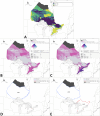Assessing avian influenza surveillance intensity in wild birds using a One Health lens
- PMID: 38832079
- PMCID: PMC11145394
- DOI: 10.1016/j.onehlt.2024.100760
Assessing avian influenza surveillance intensity in wild birds using a One Health lens
Abstract
Wildlife disease surveillance, particularly for pathogens with zoonotic potential such as Highly Pathogenic Avian Influenza Virus (HPAIV), is critical to facilitate situational awareness, inform risk, and guide communication and response efforts within a One Health framework. This study evaluates the intensity of avian influenza virus (AIV) surveillance in Ontario's wild bird population following the 2021 H5N1 incursion into Canada. Analyzing 2562 samples collected between November 1, 2021, and October 31, 2022, in Ontario, Canada, we identify spatial variations in surveillance intensity relative to human population density, poultry facility density, and wild mallard abundance. Using the spatial scan statistic, we pinpoint areas where public engagement, collaborations with Indigenous and non-Indigenous hunter/harvesters, and working with poultry producers, could augment Ontario's AIV wild bird surveillance program. Enhanced surveillance at these human-domestic animal-wildlife interfaces is a crucial element of a One Health approach to AIV surveillance. Ongoing assessment of our wild bird surveillance programs is essential for strategic planning and will allow us to refine approaches and generate results that continue to support the program's overarching objective of safeguarding the health of people, animals, and ecosystems.
Keywords: Avian influenza virus; Migratory birds; One health; Poultry; Wild birds; Wildlife disease surveillance; Zoonotic pathogen surveillance.
© 2024 Published by Elsevier B.V.
Conflict of interest statement
None.
Figures










Similar articles
-
Transmission dynamics of highly pathogenic avian influenza virus at the wildlife-poultry-environmental interface: A case study.One Health. 2024 Nov 12;19:100932. doi: 10.1016/j.onehlt.2024.100932. eCollection 2024 Dec. One Health. 2024. PMID: 39640906 Free PMC article.
-
Landscape effects and spatial patterns of avian influenza virus in Danish wild birds, 2006-2020.Transbound Emerg Dis. 2022 Mar;69(2):706-719. doi: 10.1111/tbed.14040. Epub 2021 May 6. Transbound Emerg Dis. 2022. PMID: 33600073 Free PMC article.
-
Surveillance of avian influenza viruses in South Korea between 2012 and 2014.Virol J. 2017 Mar 14;14(1):54. doi: 10.1186/s12985-017-0711-y. Virol J. 2017. PMID: 28292308 Free PMC article.
-
Identifying areas for infectious animal disease surveillance in the absence of population data: highly pathogenic avian influenza in wild bird populations of Europe.Prev Vet Med. 2010 Aug 1;96(1-2):1-8. doi: 10.1016/j.prevetmed.2010.05.002. Prev Vet Med. 2010. PMID: 20537421 Review.
-
The genetics of highly pathogenic avian influenza viruses of subtype H5 in Germany, 2006-2020.Transbound Emerg Dis. 2021 May;68(3):1136-1150. doi: 10.1111/tbed.13843. Epub 2020 Sep 29. Transbound Emerg Dis. 2021. PMID: 32964686 Review.
Cited by
-
Transmission dynamics of highly pathogenic avian influenza among multiple waterfowl species and backyard poultry: the impact of the stopover period.Sci Rep. 2025 Feb 18;15(1):5861. doi: 10.1038/s41598-025-89827-y. Sci Rep. 2025. PMID: 39966613 Free PMC article.
-
Avian influenza A (H5N1) virus in dairy cattle: origin, evolution, and cross-species transmission.mBio. 2024 Dec 11;15(12):e0254224. doi: 10.1128/mbio.02542-24. Epub 2024 Nov 13. mBio. 2024. PMID: 39535188 Free PMC article. Review.
References
-
- Clark L., Hall J. Avian influenza in wild birds: status as reservoirs, and risks to humans and agriculture. Ornithol. Monogr. 2006;60:3–29. doi: 10.2307/40166825. - DOI
-
- Ramey A.M., Hill N.J., DeLiberto T.J., Gibbs S.E.J., Camille Hopkins M., Lang A.S., Poulson R.L., Prosser D.J., Sleeman J.M., Stallknecht D.E., Wan X.-F. Highly pathogenic avian influenza is an emerging disease threat to wild birds in North America. J.Wildl. Manag. 2022;86 doi: 10.1002/jwmg.22171. - DOI
-
- Giacinti, J. A., A. V. Signore, M. E. B. Jones, L. Bourque, S. Lair, C. Jardine, B. Stevens, T. Bollinger, D. Goldsmith, B. C. W. A. S. P. (BC WASPs), M. Pybus, I. Stasiak, R. Davis, N. Pople, L. Nituch, R. W. Brook, D. Ojkic, A. Massé, G. Dimitri-Masson, G. J. Parsons, M. Baker, C. Yason, J. Harms, N. Jutha, J. Neely, Y. Berhane, O. Lung, S. K. French, L. Myers, J. F. Provencher, S. Avery Gomm, G. J. Robertson, T. Barychka, K. E. B. Gurney, J. Wight, I. Rahman, K. Hargan, A. S. Lang, M. G. C. Brown, C. Pekarik, T. Thompson, A. McLaughlin, M. Willie, L. Wilson, S. A. Flemming, M. V. Ross, J. Leafloor, F. Baldwin, C. Sharp, H. Lewis, M. Beaumont, A. Hanson, R. A. Ronconi, E. Reed, M. Campbell, M. Saunders, and C. Soos. (2023b). Avian influenza viruses in wild birds in Canada following incursions of highly pathogenic H5N1 virus from Eurasia in 2021/2022. bioRxiv. doi: 10.1101/2023.11.23.565566. - DOI
LinkOut - more resources
Full Text Sources

